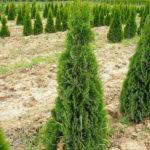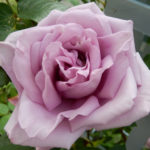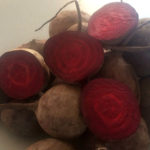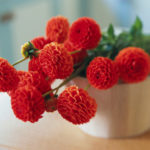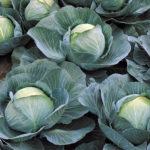Rose Fire flash (Fire flash)
Around the middle of the last century, a group of roses called "spray" was identified. Distinctive features of its representatives are the small size of the inflorescences (only 6-7 cm in diameter) and abundant flowering. Our heroine also belongs to this group - a kind of Fire Flash.
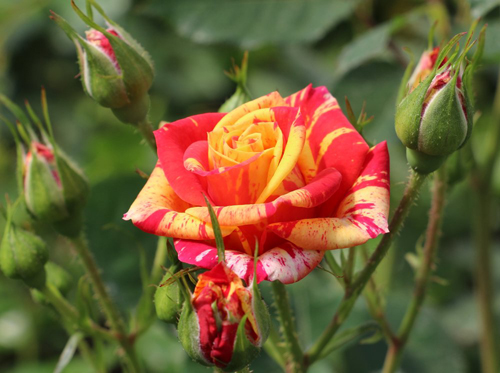
History of origin
The specified variety was bred by the breeders of the Dutch company Interplant. This company is mainly engaged in the creation of varieties of roses for cutting and the cultivation of potted forms of noble plants. The name of the Fire flash variety is translated from English as “fire flash” and perfectly reflects the originality of the color of its blossoming buds. This variety is also known under the equally resounding name Intertrofla. In addition, in different sources you can find such names of culture as "Flash Eye" and "May Fire".
Description of the variety
Fire flash has a compact size: about half a meter wide and 50 to 70 cm high. Strong shoots of the plant are covered with small, dense, dark green, shiny leaves. The flowers that appear on the shrub are small: 5-6 cm in girth. They are formed in racemose inflorescences of 5-10 pieces. The buds of this culture are characterized by a classic shape.
The most attractive in the inflorescences of this rose variety is their bright, two-tone color, combining sunny yellow and rich crimson shades. Thanks to such an unusual color, as well as the contrast of variegated buds and green foliage, the perennial looks very elegant, spectacular, cheerful. The first flowers appear on the plant in May. The blooming of a variegated rose continues until late autumn. In most cases, the flowers do not show the middle even in the phase of complete dissolution. Only a few of them show their stamens, retaining their original shape. They smell good, although the aroma they give off is rather weak.
The buds bloom on the bush slowly enough, which allows you to enjoy the wonderful spectacle to the fullest. The flowering of the decorative perennial Fire flash can be safely called lush. It takes place in three abundant waves, in between which the number of inflorescences on the bush is quite moderate.

The features of this rose include:
- high resistance to diseases and low air temperatures;
- unpretentiousness;
- preservation of the integrity and appearance of flowers under the influence of rains;
- almost complete absence of sharp thorns on the plant stems.
The flower petals of Fire Flush do not bake and do not fade in the sun, although their color still fades with age, which, however, does not negatively affect the decorative effect of the shrub.
Growing and care
The bicolor rose grows best in well-lit places that are well protected from cold, gusty winds. It grows well in partial shade. It is undesirable to place the culture in the shady corners of the garden, since under such conditions the plant is unlikely to bloom profusely. For planting a perennial, fertile, loose, light soil with a slightly acidic reaction is selected. In order to increase the level of acidity of the soil, it is enriched with manure and peat, and in order, on the contrary, to reduce this indicator, lime and wood ash are used. In the selected area, a hole is dug with a depth and width of 40-50 cm. The bottom of the hole is filled with a layer of drainage material, the role of which is suitable for small pebbles, gravel or expanded clay. Then humus is introduced into the planting pit and only after that part of the soil mixture is poured there. The seedling is lowered into the hole, the roots are straightened, and covered with the remaining earth.At the end of the procedure, they tamp the soil around the plant a little and be sure to water the rose at the root. The optimal landing time for the Fire Flush is the first half of May.
Throughout the growing season, Fire flash requires regular, moderate, and in the hot dry season, abundant watering. They are produced at intervals of 1-2 times a week in the evening or in the morning. In the spring, nitrogen fertilizers are applied under the bush to stimulate its growth and the appearance of lush green foliage. In the budding stage and in the period when flowers appear, the plant is fed with mineral complexes. At the end of flowering, the soil under the crop is fertilized with phosphorus-potassium concentrate.
With the arrival of spring, the crop requires pruning. It should affect frozen, dry, too weak and diseased shoots. In the summer, the shrub is thinned out in a moderate mode. Autumn is the time for sanitary pruning, which involves removing thin, weak branches that cannot survive the winter frosts. Despite the excellent winter hardiness, it is recommended to cover the rose for the winter with the help of spruce branches. This is especially true for young specimens. Preventive treatment of crop shoots from insect pests and diseases will not be superfluous, although the perennial has good health.
Use cases
The Fire Flash variety will successfully fit into the design of a garden or flower garden. It is used in group and mixed compositions, for decorating mixborders, planting in flower beds and on round flower beds. Often this spray rose is used to decorate garden paths. It looks spectacular against the background of a green grassy lawn, in the company of irises, lilies, fragrant herbs, ornamental grasses, undersized conifers. Fire flash can be planted along the fence, near the facade of the dwelling and at the front entrance to the house, near the gazebo, garden bench, sculptural composition. As an accent, the plant should be placed in the foreground of the flower garden. A rose bush is also appropriate in a rose garden.
The beautiful Dutch woman is suitable for growing in containers, which are placed on the veranda, balcony, terrace. It is also cultivated as a cut variety, since the flowers of this rose do not crumble for a long time and are able to give a festive look to any bouquet.
